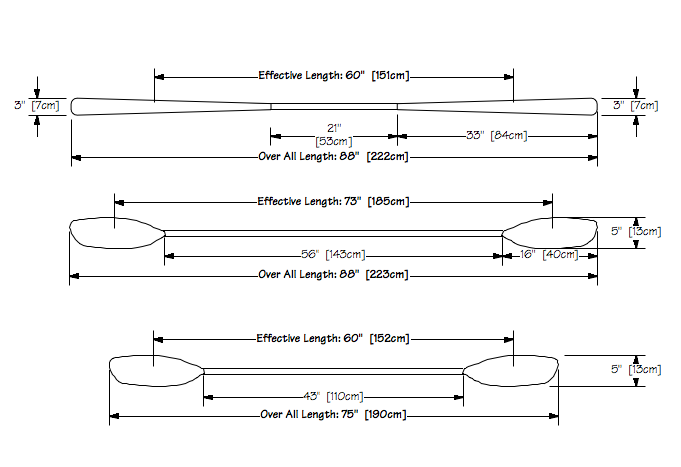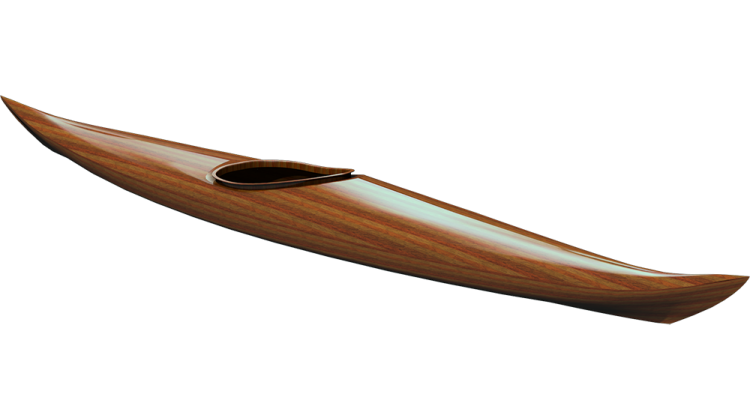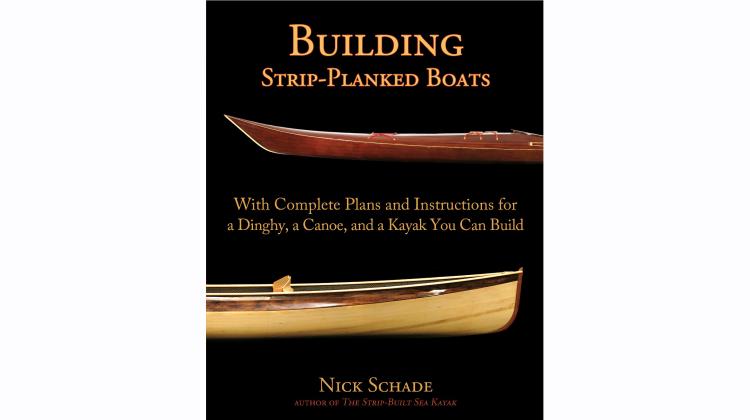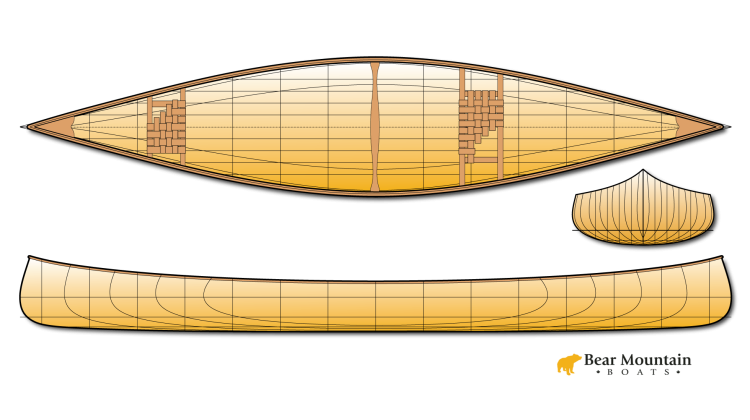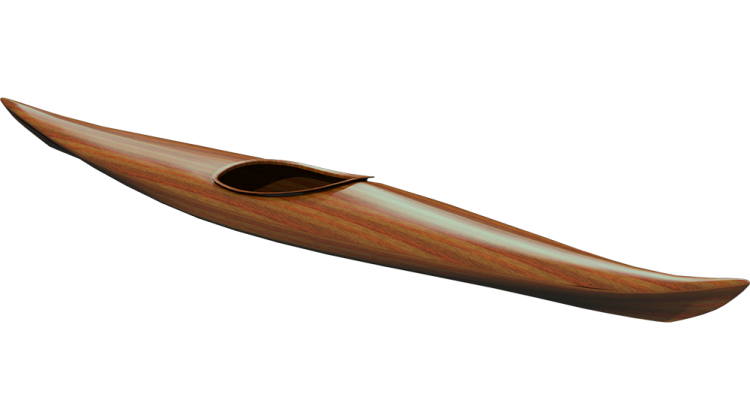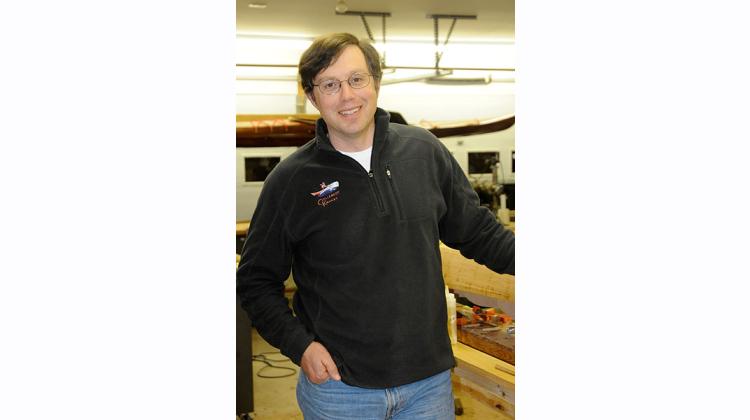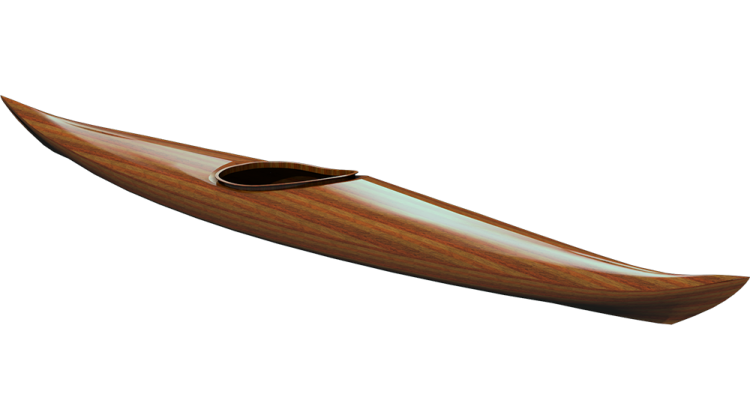One of the most important aspects of kayaking comfortably and easily is your paddle. An efficient kayak is of no use if the paddle you use is inefficient, or if you use your otherwise efficient paddle in an inefficient manner. A good paddle can make the worst boat seem better and good technique will get the most advantage out of the worst paddle.
The goal of the paddle is to push against the water so that the boat goes forward. This rather simple principle is not as simple as it seems because the water is a fluid that doesn't want to be pushed against. The act of trying to push against water tends to make the water move away from the force. And again, the goal is to make the boat move forward, making the water move backwards is a waste of effort.
Unfortunately, it is the nature of the physical world that for every action there is an equal and opposite reaction. In other words, the act of pushing a boat forward will produce the inevitable reaction of pushing something backwards. In this way the law of conservation of momentum is kept happy. Even if you put you paddle all the way down to the bottom and push off mother earth, you will actually cause the earth to rotate infinitesimally away from you. Luckily, it is unlikely that everyone on earth will paddle in the same direction simultaneously
There are several standard ways for boats to be propelled through the water. The old fashioned paddle wheel rotates like a tire and just pushed the water straight back, thus making boat go forward. The propeller works in a different way. It spins such that the blades rotate at right angles to the direction of motion for the boat. The blades of the propeller are angled such that they slice and climb through the water like a screw into wood. Paddle wheels apply power via dragging through the water. Propellors operate via lift through the water. However in basic principle they both push against the water and as a result the water starts to move.
It is through the motion of the water that inefficiency manifests itself. The effort of moving the paddle through a stroke serves to convert the mornings breakfast into motion. In an ideal system all the energy you expend would be converted directly into the kinetic energy of the boat moving through the water. Unfortunately, anything else you cause to move will also use some of the energy you applied to the paddle. Just moving the paddle through the air expends energy, but for the purpose of this discussion we will just say that a lighter paddle will require less energy to move. Otherwise we will ignore the loss of energy in moving the paddle.
 |
|
A rocket is propelled by pushing mass backwards. If the mass were cannon ball you could attain the same speed by pushing a small mass quickly (top) or a large mass slowly (bottom). The second option is more efficient as it requires less energy even though the force is exactly the same.
|
As a general principle it is more efficient to generate a propulsive force by pushing a large mass slowly than it is to push a small mass quickly. Propulsion is created by the principle of conservation of momentum. This is the "for every action there is an equal and opposite reaction" idea. Stated mathematically momentum (M) equals mass (m) times velocity (v) [M = m*v] and for momentum to be conserved, the change in momentum (–M) of the boat (–Mb) must equal the change of momentum of the water (–Mw) [–Mb = –Mw]. In other words if you are starting a 100 kilogram kayak from standstill and with you paddle make 10 kg of water move backwards at 10 meters per second, you kayak will end up moving forward at 1 meter per second [10 kg * 10 m/s = 100 kg *1 m/s]. Notice that you could get the exact same result by moving 100 kg of water at 1 m/s, or 1 kg at 100 m/s. This is where the inefficiency comes in.
While momentum is just mass time velocity, kinetic energy (KE) is mass times velocity squared [KE = m*v^2]. Kinetic energy is the amount of energy contained in the motion of the object, and that squaring of velocity is critical. This means that the amount of energy increases faster with increases in velocity than it does with increases in mass. So 1 kg of water moving at 100 m/s has 10 times the energy of 10 kg moving at 10 m/s [1 * 100 * 100 = 10,000 vs 10 * 10 * 10 = 1,000] even though they have exactly the same momentum. The reason this is important is the kinetic energy of the water is energy that used to be your breakfast and could have become kinetic energy of the kayak instead. Kinetic energy in your kayak is a good thing, it means your boat is moving. Kinetic energy in the water is a bad thing because it is gone and there is almost no way to get it back. So you will maximize your efficiency by minimizing the velocity you impart to the water as you paddle.
 |
|
As a paddle is pulled straight back against the water, the water spills around the edges. The water spins in a pair of vortice.
|
 |
|
A larger blade will effect a larger mass of water and thus does not move through the water as fast. In these examples the paddle is pushing the water towards the left, so the boat will go towards the right. Notice that water does not just move in a straight line. Since it needs to maintain the equilibrium on both sides of the paddle it most move out to the edges and then back towards the back. This circulation creates a vortex on each edge of the blade. The momentum to the side is conserved by the matching pair of vortices.
|
To create the same momentum change with lower velocity you want to maximize the mass of water you are moving. The first and easiest way to do this is make sure you use your whole paddle blade. Putting more blade area in the water will automatically increase the mass of water you have to push against with an immediate increase in efficiency. It is a common mistake for beginner kayakers to just use half the blade. Be sure you submerge the paddle blade completely in the water. You will immediately feel the paddle gain a better grip on the water. As a result, it may feel harder to paddle, but you will actually be using less energy to gain the same result so it is worth it.
Related to this is timing when you apply the power to the paddle. If you apply it to early you will end up splashing. Splashing is just another way of saying you are moving a small amount really fast. So to avoid splashing, you want to want to avoid applying power until the paddle blade is fully submerged. But you don't want to wait too long otherwise your stoke will be over before you really started. So you should try to submerge the paddle quickly so you can apply power as long as possible. Whenever you are not applying power, your boat is slowing down and the slower it gets the more effort required to bring it back up to speed.
There is another reason for waiting before applying power - "Ventilation". Ventilation is what you call it when the paddle sucks air down the back of the blade. Many people call it cavitation, but that is when a propellor spins so fast that it creates a vacuum behind the blade. Neither is any good, but what your average kayaker creates is ventilation. The reason it is no good is you are moving air instead of water. Air weighs a lot less than water and if there is air behind your paddle instead of water the mass of water you are moving is decreased and thus creating the same momentum requires you expend more energy.
There are two ways of creating ventilation. One is by bringing the air down with the blade as you insert it into the water. The other is to pull air down the back of the paddle as you apply power. Both can be avoided by being sure your blade is fully submerged before applying power. A clean entry will not bring down much water and the small area near the top of the blade is less likely to ventilate.
You can also waste energy at the end of the stroke. Again it will be indicated by splashing. If you still have a paddle full of water when you pull it out you will end up throwing it. This will often happen if you are applying power all the way until the paddle is removed from the water. Throwing water at best falls into the "moving a small mass fast" area at worst you are just lifting it and letting it drop straight down providing you with no momentum boost whatever. If you are going to throw water around you at least want it moving in a direction opposite your direction of travel.
To reiterate, your basic paddle stroke needs several things to be efficient: a fast clean entry, power while the blade is deep in the water, followed by a quick clean exit. Then you need to get started on the next stroke as soon as possible before your momentum is frittered away in drag on the boat. But I have left out an important point: where you put your paddle. A force is applied directly through the geometric center of the mass of the object. When a force is applied to the side of the mass it is actually called a "torque". Torques have the tendency to rotate the mass they are applied to. Sitting in your kayak, your center of mass is in the center of the kayak and you are sticking your paddle out to the side. The force of your paddling effort is actually creating a torque on your kayak. All your kayak really only wants is spin around its center. Luckily it is sitting in water which resists the torque. The length of your kayak sticks out ahead and behind you and when you apply the torque the boat drags against the water at the ends. This sucks up most of the force applied to the side of the boat and leaves you with just the component of the force applied up the centerline. So you move in a straight line because you are wasting some of you effort in moving water near the ends of the boat sideways.
There is not much you can do to avoid this completely, but by keeping the force as close as possible to the centerline you will minimize the amount of force wasted in keeping the boat going straight. This means keeping the paddle blade close along the side of the boat. This can be accomplished with a short paddle or by holding your paddle nearly vertical as you stroke.
To this point I have made no real mention of how the paddle actually moves through the water. The principle of maximizing the mass of water you push against applies regardless of how you do the pushing. At first it sounds pretty straight forward, you put your paddle in the water and pull it back parallel to the centerline of the boat and like a paddle wheel you are depending on the resistance of the water to create the force to propel the boat forward. If you do this you will probably have a pretty efficient paddle stroke, but there is more to it that just pulling on your paddle.
A common instruction when you are learning to paddle is to" plant your paddle like you are putting it into concrete and pull the boat to the paddle". Fortunately, water is not concrete, but the fact that it isn't does cause some problems. When you pull on your paddle it starts to move the water. The water on the power face of the blade tries to move away from the blade and the water on the back face tries to follow the paddle. The water in front of the power face needs to go some place as you push it. And it wants to go where ever is easiest. The volume behind the back face of the paddle needs to be refilled with water as the paddle pushes away the water that used to be there. The easiest place to get is from the front face which now has too much. So, water flows around the edge of the paddle. This action is typically what is called "slippage". This is an imprecise term but, it just means that the paddle moves through the water. A more technical term for what occurs at the edge of the paddle is a "vortex". This is a little eddy or whirlpool caused by the water moving from the high pressure area of the power face to the low pressure area of the back face. You will often see the remains of the vortex spinning in the water after your paddle stroke.
One aspect of paddle design worthy of note is the center of effective effort. Two paddles with the same over all length and different blade shapes may have very different effective lengths due to the relative location of the center of effort. Take the top two paddles in the image below as examples. The top paddle is a typical Greenland style paddle, and the middle is a "Euro" paddle of the same length and blade area. Because of the longer blade length of the Greenland paddle its center of effort is located closer to the center of the paddle, making it effectively the same as the bottom paddle.
